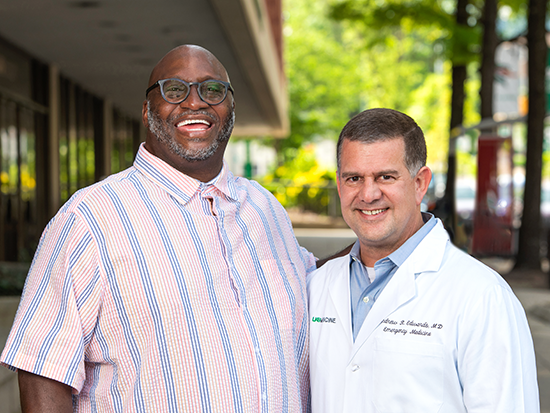The aorta is the main vessel that carries blood from your heart to the rest of your body, and it is made up of 3 layers. An aortic dissection is a tear in the wall of the aorta that occurs between the inner and middle of those 3 layers. As the tear extends along the wall of the aorta, it can cause blood to flow in between the layers of the aorta and “dissect” the layers apart, thus the name. An aortic dissection can reduce the blood flow to your brain, arms, kidneys, liver, bowels, spinal cord, and legs, depending on how it impacts the flow of blood to the branches of the aorta. The dissection can also cause the aorta to rupture, which may lead to life-threatening bleeding. An aortic dissection is a serious medical condition that occurs in about 2 out of every 10,000 people. It can develop in anyone but most often is seen in men between the ages of 40 and 70.
When the aorta leaves the heart, it first moves up through the chest toward the head; this section is called the ascending aorta. It then bends (arches) and moves down through the chest and abdomen; this section is called the descending aorta. Acute (sudden) dissection involving the ascending aorta is typically considered a surgical emergency and generally must be treated with an open operation involving removal of the dissected aorta and replacement with an artificial material. Dissection involving only the descending thoracic aorta may be treated with minimally invasive procedures such as stenting (called thoracic endovascular aortic repair, or TEVAR), open surgery, or with drugs to lower blood pressure. The choice of therapy depends on whether the dissection causes problems with flow to the branch vessels that arise from the aorta, or if there is an aneurysm associated with the dissection.
Oftentimes a delayed procedure is needed in patients due to an aneurysm that may develop over time, so strict follow-up is needed after discharge from the hospital. This is also true for patients with ascending aortic dissection that extends into the descending thoracic aorta, because of a similar risk of aneurysm over time.
The cause of aortic dissection usually involves multiple factors. Some common risks include:
- Smoking
- Uncontrolled hypertension (high blood pressure)
- Advanced age
- Hypercholesterolemia
- Bicuspid aortic valve
- Cocaine or methamphetamine use
- Narrowing (coarctation) of the aorta
- Connective tissue disorders, such as Marfan, Loeys-Dietz, or Ehlers-Danlos syndromes, among other rare genetic disorders
- Complications from open heart surgery or endovascular procedures
- Hypertension associated with pregnancy
- Aneurysm associated with conditions such as arteritis and syphilis
UAB Medicine’s vascular experts and vascular surgery specialists provide treatment for all types of circulatory conditions using a wide range of services, including medical therapy, minimally invasive endovascular procedures, and open surgical reconstruction. Our experienced vascular surgeons and physicians are leaders in their field and have excellent track records in treating some of the most complex vascular diseases and conditions. That expertise is backed by the latest and most advanced technology, facilities, and treatment options, as well as our dedication to patient-centered care. A wide range of specialists work together through the UAB Advanced Limb Preservation program to prevent the need for amputation, preserve maximum function in the lower limbs in people with peripheral artery disease (PAD), and treat associated medical conditions such as diabetes.
Our vascular experts talk extensively with each patient to determine a specific diagnosis and treatment plan based on medical history, physical exam, and a variety of non-invasive testing that includes ultrasound, Doppler with plethysmography, CT scans, and magnetic resonance angiography (MRA). We also employ three-dimensional overlay fusion technology, in which pre-operative imaging is overlaid with images captured during surgery, providing greater accuracy and improved outcomes. In addition, we maintain an operating room designed specifically for vascular therapies, where we perform “hybrid” procedures that combine both open surgery and minimally invasive endovascular techniques and maximize the benefits of both.
As a major academic medical center, UAB maintains an active research program that also manages clinical trials. Our commitment to innovation and discovery often means that patients have access to advanced new treatments long before they are available to the general public.
Resources
- UAB Division of Vascular Surgery and Endovascular Therapy
- UAB Division of Cardiothoracic Surgery
- American Heart Association
Related Specialties
- Aortic Aneurysm
- Aortic Insufficiency
- Aortic Periprosthetic Leak
- Aortic Stenosis
- Aortic Valvuloplasty
- Vascular Disease
Clinical Trials
Speak to your physician about your options and browse the link below for more information
Latest News
View All News-
UAB study reveals link between transthyretin levels and heart disease risk
July 26, 2024
-
UAB Hospital continues to be the best hospital in Alabama, Birmingham metro, according to U.S. News & World Report
July 16, 2024
-
New UAB study evaluates cardiovascular health scores in predicting mortality risks
June 26, 2024
-
UAB first in world to use new device for electrophysiology procedures
June 24, 2024
-
UAB offers new treatment for patients with uncontrolled hypertension
June 6, 2024



